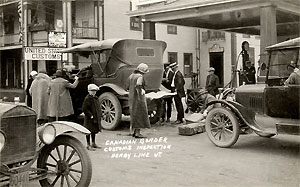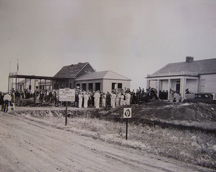Autos, Alcohol, and Immigrants: How Border Stations Came to Be
Three profound cultural changes led to the design, construction, and location of the border inspection stations. They were: the American love affair with the automobile, regulation of immigration, and Prohibition.
Advent of the Automobile

Derby Line, Vermont, circa 1930. The first Customs and Immigration border inspection station was located in the Derby Line Hotel. Inspections took place in the street which led to the international crossing to Rock Island, Canada.
Throughout the 1920s, motor vehicles became more economical and reliable, and purchases boomed in the U.S. In response, the government improved and added roads and highways to meet the needs of American drivers. These roads included those that crossed the international borders with Canada and Mexico. This was a profound shift in travel and immigration to the United States. For the first time in the history of the U.S., the majority of people entering the country came by land, not water.
Tighter Immigration Laws
After the passage of the Immigration Act of 1917, each adult alien over 16 years old entering the United States was required to: 1) prove he or she could read approximately 40 words of English; and 2) pay a tax of $8. (According to this U.S. Bureau of Labor Statistics inflation calculator, this is equal to more than $125 in 2016.) These requirements immediately fueled widespread evasions of customs.
In 1921, Congress passed the first law establishing annual immigration quotas, by country, causing many of those who had failed to gain entry to the U.S. under the quotas to try to illegally enter via the Canadian border.
Prohibition

U.S. Border Inspection Station, St. John, North Dakota
Finally, the passage of the Volstead Act and the ratification of the 18th Amendment to the U.S. Constitution, which prohibited the sale and consumption of alcoholic beverages between 1919 and 1933, led to increased smuggling of alcohol across international boundaries.
How the Auto Boom Affected Customs Stations: A Case Study
At the Highgate, Vermont customs stations, in 1919: customs inspectors examined only about 2,200 automobiles entering the U.S. from Canada.
Within five years, cross-border auto traffic through Highgate had increased to more than 23,000 vehicles.
By 1931, the number of automobiles and trucks passing through customs and immigration at Highgate had risen to over 110,000. While not every border station kept such careful records, it may be assumed that the Highgate experience was shared by officials from other border inspection stations.
A report from the Secretary of the Treasury’s office affirmed that by 1930 “almost four times as many [persons] entered the U.S. by highway as by boat, and more than three times as many as the combined number that entered by boat and railroad.”
How Border Station Sites Were Selected
Locations of border stations were determined through analysis of traffic data and consideration of where paved roads existed or were likely to be developed in the near future. A guiding principle was that new stations should be situated as close to the actual boundary line as possible, “before traffic has an opportunity to scatter and where the officers on duty can have positive knowledge that the traffic coming under their observation has crossed the international line.” (Benner, H. A. and J. L. Hughes. 1928. Congressional report to the Commissioner General of Immigration. Washington, DC, May 13:25.)
With these concerns in mind, the Treasury Department publicly solicited offers for possible station sites. (GSA, who now oversees the historic border stations, was not founded until 1949.) Upon receipt of offers, representatives from the Office of the Supervising Architect conducted investigations to determine which of the offered sites would best serve the government’s requirements. Preferred sites were those that were adjacent to the boundary line, on the United States-bound side of the road, and of sufficient size to accommodate the proposed facility.
Continue to Legislative and Research History

 U.S. General Services Administration
U.S. General Services Administration

